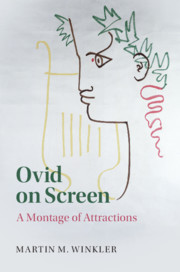Book contents
- Ovid on Screen
- Ovid on Screen
- Copyright page
- Dedication
- Contents
- Illustrations
- Acknowledgments
- D M
- Adages
- Fade-In: Prooemium
- Part I Theory and Practice
- Part II Key Moments in Ovidian Film History
- Chapter 3 D’Annunzio’s Ovid and the Cinematic Impulse
- Chapter 4 The Labyrinth: Narrative Complexity, Deadly Mazes, and Ovid’s Modernity
- Part III Into New Bodies
- Part IV Love, Seduction, Death
- Part V Eternal Returns
- Sphragis: End Credits
- Bibliography
- Passages of Ovid’s Works
- General Index
- Plate Section (PDF Only)
Chapter 3 - D’Annunzio’s Ovid and the Cinematic Impulse
from Part II - Key Moments in Ovidian Film History
Published online by Cambridge University Press: 27 January 2020
- Ovid on Screen
- Ovid on Screen
- Copyright page
- Dedication
- Contents
- Illustrations
- Acknowledgments
- D M
- Adages
- Fade-In: Prooemium
- Part I Theory and Practice
- Part II Key Moments in Ovidian Film History
- Chapter 3 D’Annunzio’s Ovid and the Cinematic Impulse
- Chapter 4 The Labyrinth: Narrative Complexity, Deadly Mazes, and Ovid’s Modernity
- Part III Into New Bodies
- Part IV Love, Seduction, Death
- Part V Eternal Returns
- Sphragis: End Credits
- Bibliography
- Passages of Ovid’s Works
- General Index
- Plate Section (PDF Only)
Summary
The next two chapters deal with key aspects of direct and indirect Ovidianism in film history. Chapter 3 details a particular moment, both Ovidian and cinematic, in the artistic development of Gabriele D’Annunzio, once Italy’s pre-eminent writer, and its far-ranging repercussions for D’Annunzio and all of film history. D’Annunzio saw himself as an artistic and spiritual descendent of Ovid. His poems, especially Alcyone, provide ample evidence. Daphne’s metamorphosis into a laurel tree in the Metamorphoses prompted D’Annunzio to abandon his earlier disdain for the new medium of cinema and to make film history himself: in his practical involvement with several productions and in regard to the origins of film stardom. D’Annunzio became one of the first formulators of film theory, perhaps the first ever. This chapter also addresses the Ovidian nature of a pre-cinematic apparatus such as the thaumatrope and the impulse that American educators received from early cinema and D’Annunzio. None of this would have occurred the way it did without Ovid in the background.
- Type
- Chapter
- Information
- Ovid on ScreenA Montage of Attractions, pp. 83 - 118Publisher: Cambridge University PressPrint publication year: 2020

